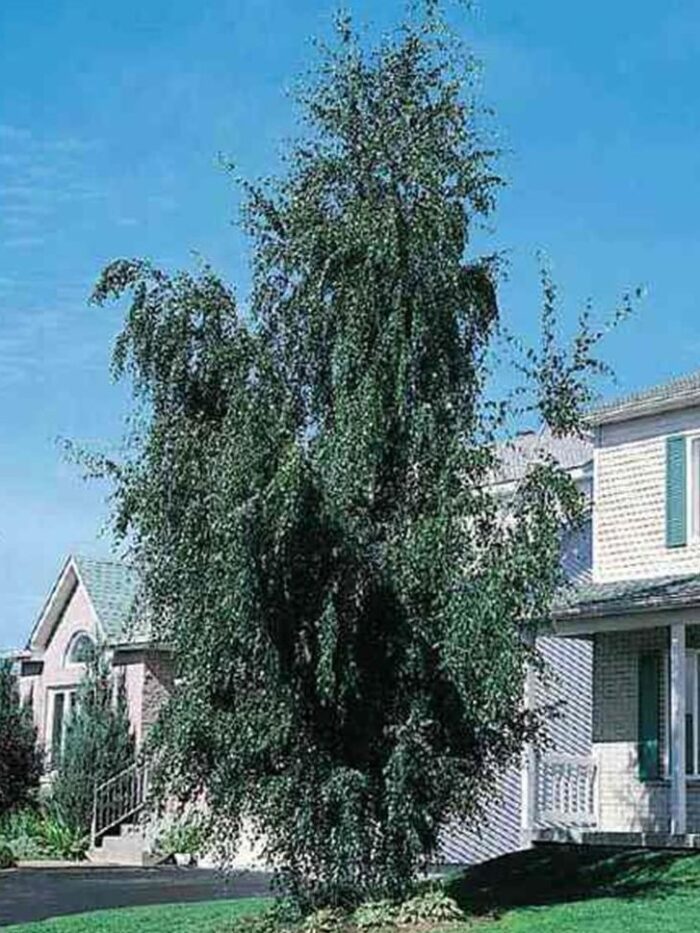Riverdene Garden Center
Cutleaf Weeping Birch
Cutleaf Weeping Birch
Couldn't load pickup availability
Betula pendula ‘Laciniata’
Cutleaf Weeping Birch is a graceful, elegant deciduous tree with deeply cut, feathery leaves, cascading branches, and striking white bark. It is a fast-growing, cold-hardy (Zone 2-6) ornamental tree, making it an excellent choice for prairie landscapes, parks, and large yards in Southwest Saskatchewan.
Although it thrives in cold climates, it is susceptible to Bronze Birch Borer (BBB), so proper care is crucial for maintaining tree health.
Planting & Location
- Hardiness Zone: 2-6 (very cold-hardy but requires care in hot, dry climates)
- Mature Size: 30-40 feet tall, 20-30 feet wide
- Growth Rate: Fast (2+ feet per year)
- Sunlight Needs: Full sun to partial shade (best in 6+ hours of sunlight)
-
Soil Preference:
- Prefers moist, well-drained, loamy soil.
- Tolerates clay, sandy, and slightly alkaline soils.
- Avoid drought-prone or compacted soil, as birches have shallow roots.
- Spacing: 20-30 feet apart to allow for full canopy development.
Watering
- Young Trees (First 2-3 Years): Water deeply once per week to establish roots.
- Established Trees: Requires consistent moisture, water every 1-2 weeks in dry conditions.
- Avoid Drought Stress: Birch trees prefer cool, moist roots, so mulching is essential.
Fertilizing
- First Year: No fertilizer needed—focus on root development.
-
Mature Trees:
- Apply a slow-release balanced fertilizer (e.g., 10-10-10) in early spring if growth is slow.
- Organic alternative: Mulch with compost or aged manure in spring to retain moisture and provide nutrients.
Pruning & Maintenance
- Best Time to Prune: Late summer to early fall (Avoid pruning in spring, as birches bleed sap heavily).
-
How to Prune:
- Remove dead, diseased, or crossing branches to improve airflow.
- Maintain a strong central leader to prevent weak branch structure.
- Minimal pruning required for its natural weeping shape.
Pest & Disease Management
Common Pests:
-
Bronze Birch Borer (BBB) – A major threat to stressed trees.
- Solution: Keep trees healthy, well-watered, and mulched to reduce risk. If infested, apply systemic insecticide in early spring.
-
Aphids – Can cause curled leaves and sticky honeydew.
- Solution: Spray with insecticidal soap or introduce ladybugs.
-
Leaf Miners – Cause brown blotches on leaves.
- Solution: Remove affected leaves and apply neem oil if severe.
Common Diseases:
-
Leaf Spot (Marssonina betulae) – Causes brown or black spots.
- Solution: Rake and remove infected leaves; apply fungicide if needed.
-
Anthracnose – Fungal disease causing leaf blight.
- Solution: Avoid overhead watering and prune for airflow.
-
Canker (Bacterial or Fungal) – Causes branch dieback.
- Solution: Prune out affected branches and improve tree health.
Winter Protection
- Young Trees: Wrap trunks with tree guards or burlap to prevent sunscald and frost cracks.
- Mulching: Apply 2-4 inches of mulch around the base (not touching the trunk) to insulate roots.
- Rodent & Deer Protection: Use tree guards to prevent bark damage.
Landscape Uses
Stunning ornamental tree for large yards and parks
Fast-growing with a beautiful weeping habit
Bright white bark provides year-round interest
Deeply cut leaves create light, airy shade
Attracts pollinators and songbirds
Additional Notes:
- Cutleaf Weeping Birch is one of the most beautiful birch varieties but requires consistent moisture and protection from borers.
- Lifespan: 30-50 years with proper care.
- Works well as a specimen tree, in cottage gardens, or near water features.
Photo courtesy of Jeffries Nurseries
Share


